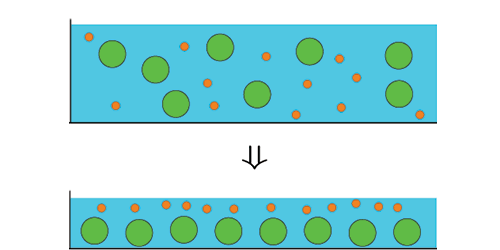Little Spheres Are Pushy
Watching paint dry can, it turns out, give us something to talk about. In 2016, researchers studying liquids like paints and inks, which contain a suspension of particles, found that after drying a film of the liquid, the smallest particles were at the top. Theorists in China have now used a diffusion model to predict the conditions under which this “small-on-top” situation or its inverse will occur. The team’s model might also help in the design of coatings and other industrial products that require stratified particles.
In an evaporating liquid that contains particles with a distribution of sizes, the smallest particles should be the first to diffuse away from the film’s surface, where the particle concentration is relatively high. But the 2016 study revealed instead that when the ratio of small to big particles is large, smaller particles stay near the top of the film, both in simulations and in experiments (see 18 March 2016 Focus story).
To explain this effect, Jiajia Zhou and colleagues from Beihang University in China imagined an evaporating film containing a mixture of little and big spherical particles. They described each particle type with a standard diffusion equation that accounted for an interaction between the two particle sizes. This interaction, however, isn’t symmetric: a big particle has a harder time squeezing into a concentrated region than a little particle, much like an adult finds it harder to pass through a crowd than a child. This asymmetry pushes big particles away from the surface. And it becomes more pronounced when there’s a large difference between the particle sizes or if the small particles greatly outnumber the big ones—two scenarios that lead to a small-on-top stacking.
This research is published in Physical Review Letters.
–Jessica Thomas
Jessica Thomas is the Editor of Physics.





